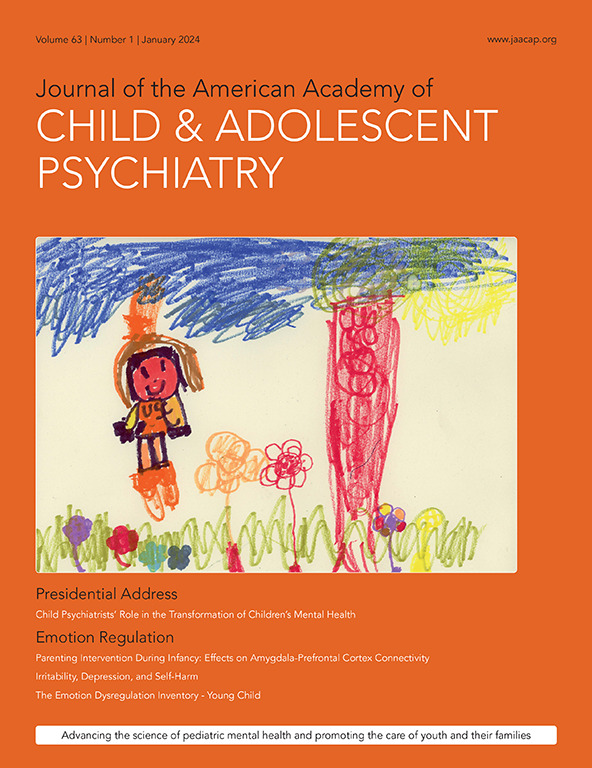青少年早期移民青年的心理健康、少数民族压力因素与心理弹性因素。
IF 9.5
1区 医学
Q1 PEDIATRICS
Journal of the American Academy of Child and Adolescent Psychiatry
Pub Date : 2025-05-15
DOI:10.1016/j.jaac.2025.05.005
引用次数: 0
摘要
目的移民青年在美国是一个庞大的人口群体,然而关于早期青少年移民的心理健康和独特的个人层面风险和保护因素的研究有限。先前的研究揭示了移民和精神病理之间的可变关联。我们的目的是表征少数民族的压力因素,保护因素和青少年移民的心理健康。方法分析青少年大脑认知发展研究数据(N=10,310,平均年龄=12.9,男性占52.3%),其中第一代移民青年227人(G1,在国外出生),第二代移民青年1,033人(G2,在美国出生,父母双方都在美国出生),第三代移民青年489人(G3,青年和父母在美国出生,≥2祖父母在美国出生)和8,561名非移民青年。我们比较了移民相关风险和保护因素的暴露,并使用线性混合效应模型来检验移民及其相关风险和保护因素(自变量)与自我报告的精神病理(因变量)之间的关联,并根据人口统计学进行调整。结果与非移民青年相比,G1和G2青年经历了更多的移民相关压力源(对原籍国的歧视、美国人的内化排斥),对美国文化的认同程度较低,但在精神病理上没有差异。G1和G2青年对其传统文化的认同程度更高,这与较少的精神病理有关。G3青年在所有指标上总体上与对照组相似。当使用父母报告精神病理学时,研究结果在种族和民族群体中普遍一致。结论早期青少年一代和二代移民尽管暴露于少数民族压力源较多,但心理健康具有弹性。研究结果表明,强大的遗产和美国文化认同可能是美国移民青年的关键适应因素。本文章由计算机程序翻译,如有差异,请以英文原文为准。
Mental Health, Minority Stressors and Resilience Factors Among Early Adolescent Immigrant Youth.
OBJECTIVE
Immigrant youth are a large population in the U.S, yet there are limited studies characterizing mental health and unique individual-level risk and protective factors in early adolescent immigrants. Previous studies reveal variable associations between immigration and psychopathology. We aimed to characterize minority stressors, protective factors, and mental health among adolescent immigrants.
METHOD
We analyzed data from the Adolescent Brain Cognitive Development Study (N=10,310, mean age=12.9, 52.3% males), which included 227 first-generation immigrant youth (G1, foreign-born), 1,033 second-generation immigrant youth (G2, US-born, both parents born outside US), 489 third-generation immigrant youth (G3, youth and parents US-born, ≥2 grandparents born outside US) and 8,561 non-immigrant youth. We compared exposure to immigration-related risk and protective factors and used linear mixed-effects models to test associations between immigration and its related risk and protective factors (independent variables) with self-reported psychopathology (dependent variable), adjusting for demographics.
RESULTS
Compared to non-immigrant youth, G1 and G2 youth experienced more immigration-related stressors (discrimination against country of origin, internalized rejection by Americans), and identified less with American culture, yet showed no differences in psychopathology. G1 and G2 youth reported greater identification with their heritage culture, which was associated with less psychopathology. G3 youth were overall similar to controls in all measures. Findings were generally consistent across racial and ethnic groups and when using parent-report psychopathology.
CONCLUSION
Early adolescent first- and second-generation immigrants have resilient mental health despite greater exposure to minority stressors. Findings suggest strong heritage and American cultural identity may be key resilience factors among US immigrant youth.
求助全文
通过发布文献求助,成功后即可免费获取论文全文。
去求助
来源期刊
CiteScore
21.00
自引率
1.50%
发文量
1383
审稿时长
53 days
期刊介绍:
The Journal of the American Academy of Child & Adolescent Psychiatry (JAACAP) is dedicated to advancing the field of child and adolescent psychiatry through the publication of original research and papers of theoretical, scientific, and clinical significance. Our primary focus is on the mental health of children, adolescents, and families.
We welcome unpublished manuscripts that explore various perspectives, ranging from genetic, epidemiological, neurobiological, and psychopathological research, to cognitive, behavioral, psychodynamic, and other psychotherapeutic investigations. We also encourage submissions that delve into parent-child, interpersonal, and family research, as well as clinical and empirical studies conducted in inpatient, outpatient, consultation-liaison, and school-based settings.
In addition to publishing research, we aim to promote the well-being of children and families by featuring scholarly papers on topics such as health policy, legislation, advocacy, culture, society, and service provision in relation to mental health.
At JAACAP, we strive to foster collaboration and dialogue among researchers, clinicians, and policy-makers in order to enhance our understanding and approach to child and adolescent mental health.

 求助内容:
求助内容: 应助结果提醒方式:
应助结果提醒方式:


